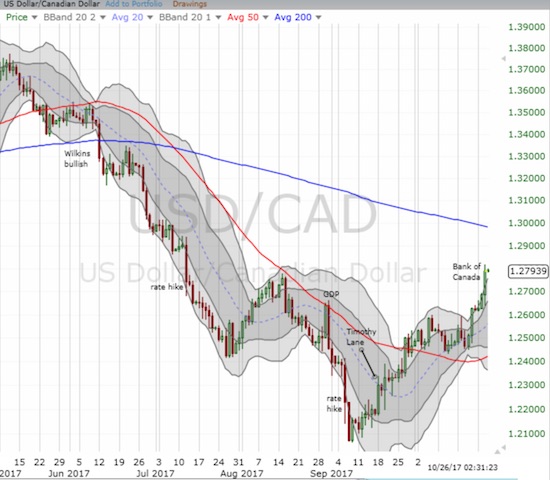Central banks are getting pretty good at having it both ways. Despite two rate hikes, one in July and one in September, the Bank of Canada (BoC) has talked its way to a net no change in the Canadian dollar (FXC) versus the U.S. dollar (DXY0).

The U.S. dollar made a higher high against the Canadian dollar on the way to what looks like an imminent test of 200DMA resistance for USD/CAD.
Source: FreeStockCharts.com
As the chart above shows, the Canadian dollar has been on a definitive weakening trend against the U.S. dollar since the low of USD/CAD in early September. In particular, Deputy Director Timothy Lane helped to push USD/CAD off its bottom when he suggested that the Bank of Canada may be balking at the strengthening of the Canadian dollar. A week and a half later, the Canadian dollar broke out above its 50-day moving average (DMA) and confirmed the bottom. Today (October 25, 2017), the market responded bearishly yet again to what appears to be a very dovish statement on monetary policy. Yet, this fresh selling is a bit of a surprise given Lane gave a preview of the BoC’s return to dovish talk. From he suggested that the Bank of Canada may be balking at the strengthening of the Canadian dollar:
“…the Bank of Canada’s future monetary policy decisions may depend on the strength of the Canadian dollar (FXC). When the Bank of Canada cut rates in the wake of the collapse in oil prices, the Bank floated its hopes for driving stronger exports to ease Canada’s transition. While exports did not rebound as strongly as expected, the economy as a whole seemed to benefit. It makes sense that the Bank is now wary about how well the economy can or will absorb a stronger exchange rate. USD/CAD last traded at current levels in May, 2015.”
While I acknowledged the dovish implications of Lane’s comments, I still thought the market’s trigger finger response was overdone. Instead the move turned out the beginning of a new trend against the Canadian dollar. I thought the market would finish pricing in the change in BoC positioning by the time of the decision, but it seems the market still wanted to hear and see confirmation.













Leave A Comment